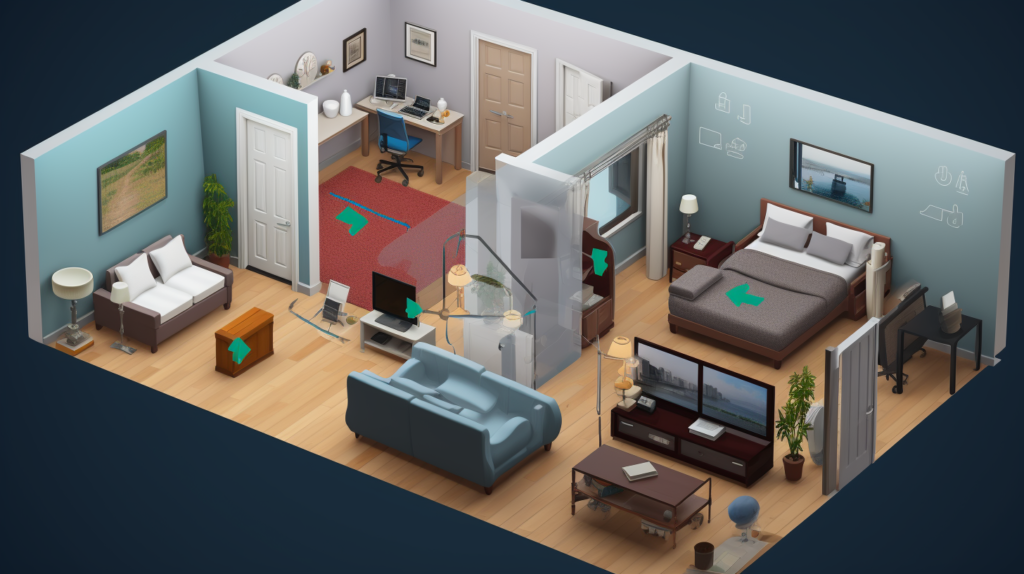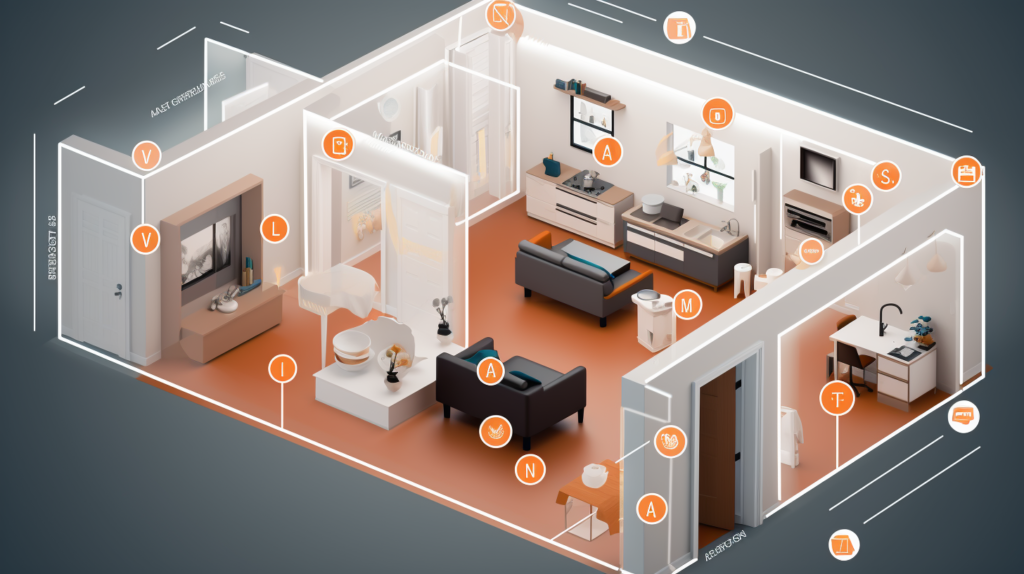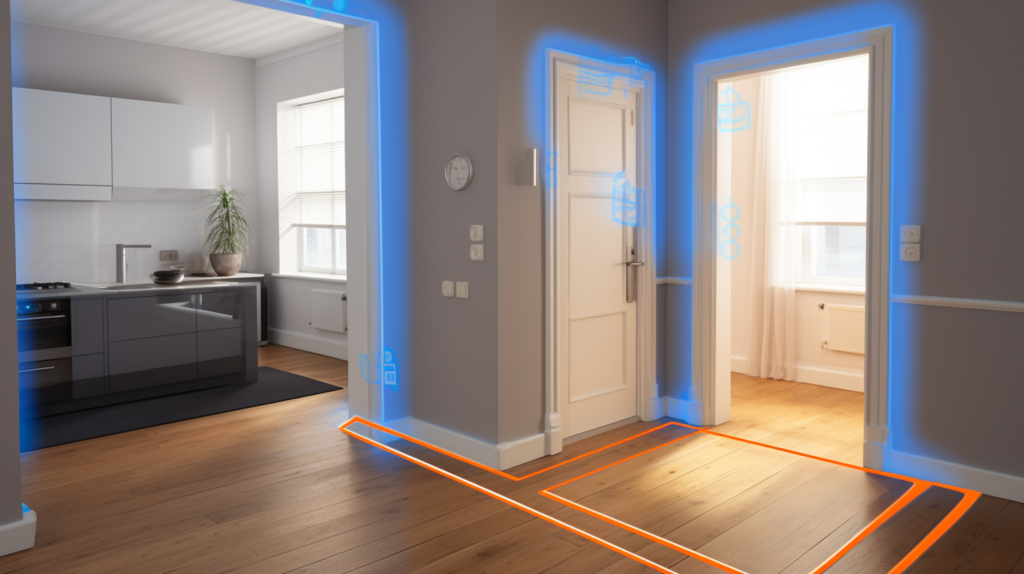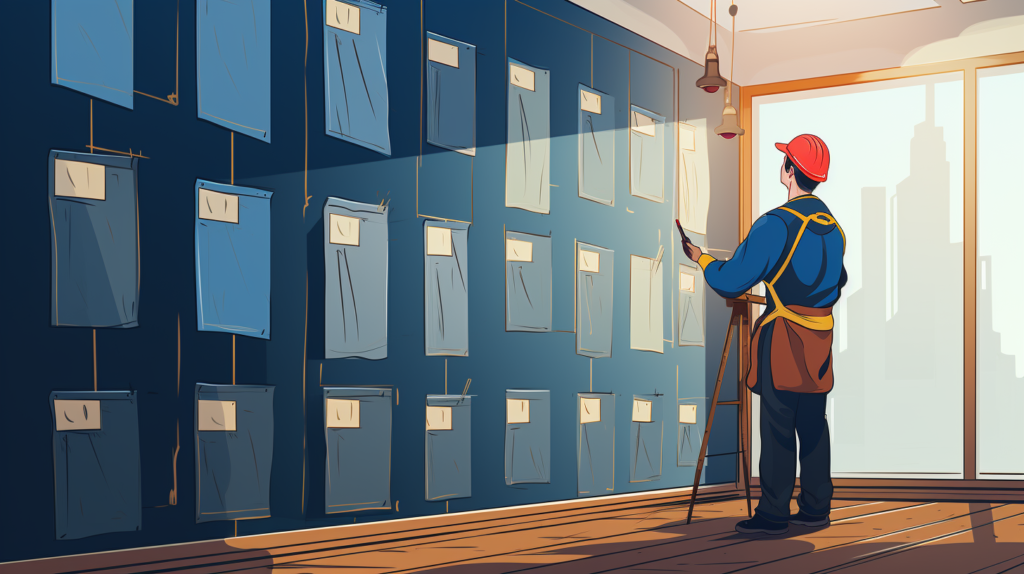Are you tired of hearing your neighbor’s late-night TV marathons or the constant footsteps from the apartment above? You’re not alone.
Noise is one of the most common complaints among apartment dwellers, but it doesn’t have to be an unavoidable part of your life.
In this comprehensive guide, we’ll walk you through the essential steps to soundproof your apartment effectively.
From identifying the types of noise and their sources to choosing the right materials for each surface, we’ve got you covered.
You’ll even learn some budget-friendly hacks that won’t break the bank but will significantly improve your living space.
So, are you ready to turn your noisy apartment into a peaceful sanctuary? Let’s dive in to find the best soundproofing solutions tailored just for you.
1. Identifying Your Noise Problem

In any soundproofing project, the first critical step is to identify the type of noise you’re dealing with. It sounds simple, but different types of noise will require different treatment strategies.
Airborne noise is often the most common type of noise in apartment complexes. This category includes the noise from televisions, music systems, and human voices.
These sounds travel through the air and can penetrate walls, ceilings, and floors, making them a pervasive problem.
Another familiar culprit is impact noise, sometimes known as structure-borne noise. This is the sound that you hear when someone walks across the floor above you or moves furniture.
It’s the type of noise that’s transmitted through the building’s structure, and it can be incredibly disruptive.
The rhythmic thud of footsteps or the scraping of a chair can quickly become a significant nuisance.
Then there’s flanking noise, a sneaky infiltrator that takes a roundabout path into your living space.
Even if you’ve invested time and money in soundproofing your walls or floors, flanking noise can still penetrate your apartment through unexpected paths like ductwork, plumbing, or even electrical outlets.
Understanding flanking noise is crucial because it can undermine all your other soundproofing efforts.
Sources of Noise
Knowing where the noise is coming from can significantly influence your soundproofing strategy. In apartment settings, noise commonly emanates from several sources.
Your neighbors are often the most obvious source. Whether they’re watching a movie at full volume, hosting a party, or just walking around, their activities can translate into noise in your apartment.
Sometimes the source of the noise could be closer to home. Household appliances like washing machines, dishwashers, and air conditioners can also contribute to your noise problem.
Therefore, understanding the source of your noise problem is crucial. It allows you to develop a targeted strategy rather than adopting a one-size-fits-all approach.
Knowing where the noise is coming from helps you decide which surfaces to focus on for soundproofing.
If the majority of noise is coming from your neighbors, then walls might be your primary concern.
On the other hand, if footsteps or moving furniture sounds from an upstairs apartment are your main issue, then the ceiling is where you’ll want to focus your soundproofing efforts.
2. Choosing the Surfaces to Soundproof

Once you’ve identified the types and sources of noise you’re dealing with, the next step is to choose which surfaces to soundproof.
This is where a targeted approach can save you both time and money. If, for example, the primary source of your noise problem is an upstairs neighbor, then it makes sense to focus on soundproofing your ceiling. If the noise is coming through shared walls, those become your priority.
Tailoring Your Approach to Your Needs
Every apartment is unique, and so are its noise issues. It’s not just about where the noise is coming from but also how it affects your daily life.
If you work from home, for example, your main concern may be to soundproof your home office. The same applies if you have a baby; soundproofing the nursery becomes a priority.
Customizing your soundproofing strategy based on your living circumstances is not just smart but also cost-effective.
3. Understanding Soundproofing Options for Each Surface

Soundproofing an apartment can seem like a daunting task, especially when you’re on a budget and not sure where to start.
Yet, with a targeted approach that focuses on specific noise challenges, you can create a peaceful living environment without breaking the bank. Here are some surface to target and how to soundproof them
Soundproofing Doors
Doors are often overlooked when it comes to soundproofing, but they can be a significant source of noise infiltration.
Soundproofing your doors involves several methods, from adding weatherstripping to installing a solid core door.
You can even go as far as to install a door sweep at the bottom of the door to seal any gaps. For a more detailed guide, refer to our in-depth article on how to soundproof doors.
Soundproofing Windows
Windows are another common weak point in an apartment’s soundproofing. Single-pane windows are particularly bad at blocking out noise.
Upgrading to double or triple-pane windows can make a significant difference. Sealing gaps and even using soundproof curtains can also help.
For more tips and techniques, check out our comprehensive guide on how to soundproof windows.
Soundproofing Walls
Shared walls in an apartment are a frequent source of noise complaints.
There are several ways to soundproof walls, from adding mass with extra layers of drywall to using resilient channels to create a gap between the wall and the drywall.
Another effective method is to add acoustic panels, which can absorb a significant amount of sound. Polyester acoustic panels are particularly effective and are also an eco-friendly option.
For a step-by-step guide on soundproofing your walls, refer to our detailed article on the subject.
Soundproofing Ceiling
The ceiling is often the most challenging surface to soundproof, especially in an apartment. However, it’s also one of the most critical if you have noisy upstairs neighbors.
Acoustic ceiling tiles can be a good option, as can a suspended ceiling.
Soundproofing the ceiling may involve more complicated procedures like decoupling, which separates the ceiling structure from the joists, effectively creating a gap where sound waves can dissipate.
For a complete guide on how to tackle this complex task, refer to our article focused on soundproofing ceilings.
Soundproofing Floors
Last but certainly not least, floors are a major contributor to noise issues in apartments.
Whether it’s your footsteps echoing down to the apartment below or noise coming up from a busy street, soundproofing your floors can make a world of difference.
Rubber acoustic underlayments are a popular choice for reducing impact noise, and they are relatively easy to install.
Floating floors offer another effective option, providing a layer of separation that helps to minimize both airborne and impact noise.
For a full guide on how to soundproof your floors, you can refer to our in-depth article on the subject.
What Are The Budget-Friendly Soundproofing Techniques?

Budget constraints often limit what you can do in terms of soundproofing your apartment. Fortunately, there are cost-effective options that can still significantly mitigate noise.
Sometimes, it’s the simple things that make the biggest difference. Placing a rug on your floor, for example, can dampen impact noise, making life a little quieter for your downstairs neighbors.
It’s easy to get carried away with high-end soundproofing solutions, but often a balanced approach is more sustainable.
Mixing and matching expensive and budget-friendly options can yield excellent results. For example, you might splurge on a solid core door but save money by making your own DIY window plugs.
The trick is to prioritize and invest where it makes the most sense for your specific noise challenges.
Common Mistakes to Avoid

It’s easy to focus on the large surfaces like walls and floors and overlook the small gaps that can let sound in.
Caulking around windows, adding door sweeps, and sealing gaps where utilities enter the apartment can make a noticeable difference.
These are small tasks that often get overlooked but can significantly contribute to a quieter living space.
While it’s easy to focus purely on blocking out sound, it’s also important to consider the acoustic quality within your apartment.
Sometimes, soundproofing can make an apartment too “dead” acoustically, which can be just as uncomfortable as too much noise.
Polyester acoustic panels can be particularly useful here, as they absorb sound without killing the acoustics of a room.
Follow-Up and Maintenance

Once you’ve invested time and money into soundproofing your apartment, it’s essential to make sure those efforts are paying off.
Regularly inspect your soundproofing measures to ensure they’re still effective. Weatherstripping can wear out, and even high-quality materials can degrade over time.
Keeping an eye on these elements will save you from sudden noise disruptions.
As you continue to live in your soundproofed apartment, you may find that new noise challenges emerge.
Perhaps a new neighbor has different noise habits, or you’ve brought a pet into your home. Periodic updates and upgrades to your soundproofing measures can help you adapt to new noise environments.
If something isn’t working as well as it used to, don’t hesitate to replace or upgrade it.
Conclusion
Soundproofing an apartment is not a one-size-fits-all endeavor but rather a targeted approach to creating a more peaceful living space.
By understanding the specific types of noise you’re dealing with, pinpointing the sources, and then focusing on the most impacted surfaces, you can achieve effective soundproofing without unnecessary expense.
Whether you’re dealing with noisy neighbors or the hustle and bustle of city life seeping into your apartment, taking a tailored approach to soundproofing can yield significant benefits.
From high-end solutions like acoustic panels and floating floors to budget-friendly hacks like rugs and weatherstripping, there are options for everyone.
Remember, soundproofing is not just a one-time project but an ongoing process. Regular maintenance and updates will ensure that your apartment remains a sanctuary of peace and quiet.
With this comprehensive guide, you’re now well-equipped to take on the soundproofing challenges in your apartment and come out victorious.
